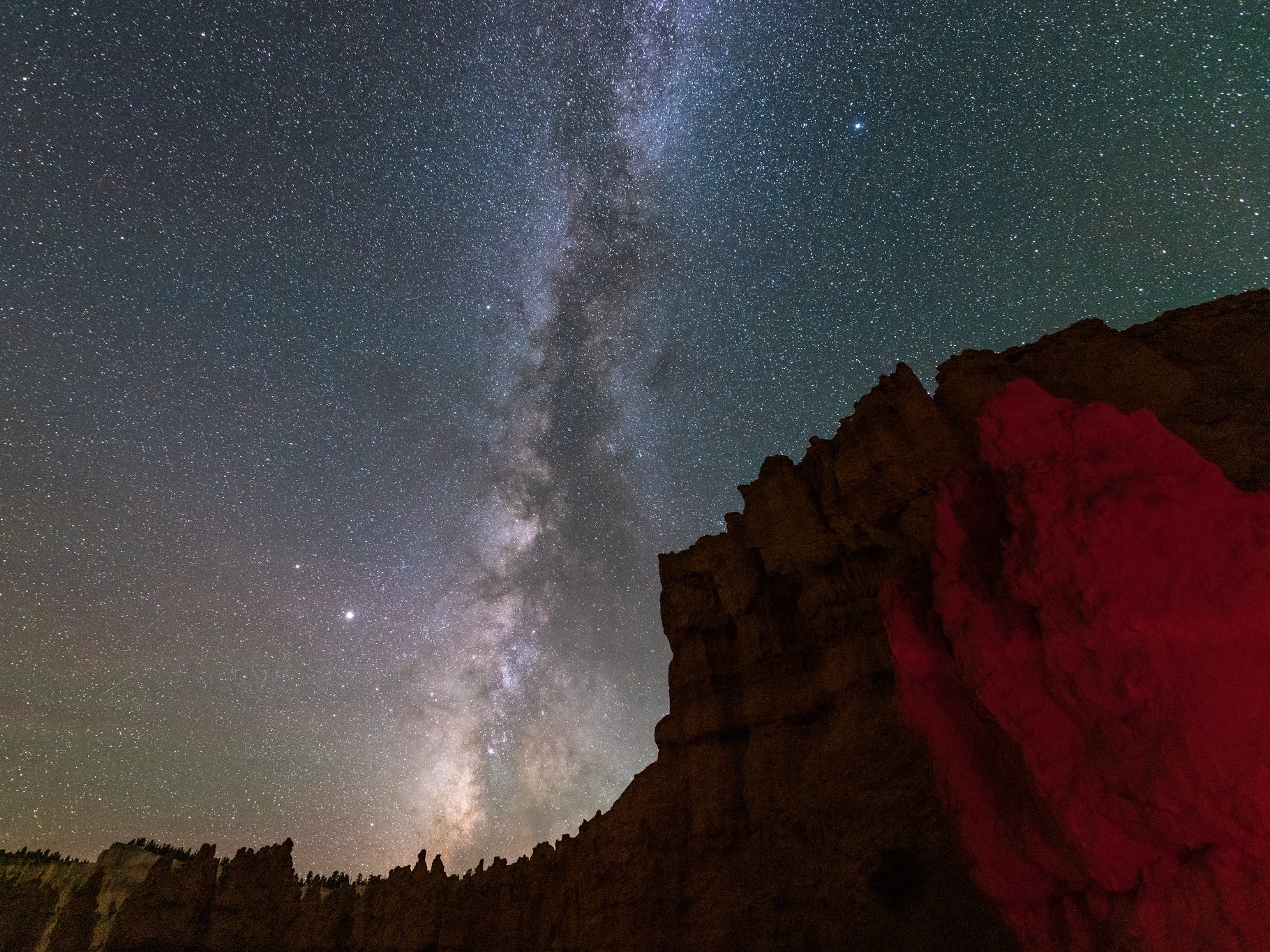Last updated on January 26th, 2023 at 01:58 pm
Runners, climbers, campers, hikers, and even at-home grill masters utilize headlamps. However, when you cycle through the light settings, the red light is confusing and curious. Many outdoorsy people wonder what is the red light for on a headlamp? Likely borrowed from military tactics, the red beam serves a number of purposes that outdoor adventurers should be familiar with.
For instance, red light preserves your vision, decreases light pollution, keeps bugs away, and attracts attention in emergency situations.
1. Better Peripheral Vision
Firstly, did you know that your peripheral vision is more affected by light than your central vision? We’ve often heard it explained as the ‘eagle eye vs owl eye.’
During the day, we use our “eagle eye” to see because we generally focus on something by looking directly at it.
In the darkness, however, because we’re unable to focus on anything specific, we resort to our ‘owl eye.’
Our periphery is a built-in survival mechanism for navigating the darkness. The peripheral vision becomes our primary source of sight as we unknowingly scan our surroundings.
We love the red light on our headlamps, and we’ve compiled a list of our favorites on the market in our 7 Headlamps Perfect for Hiking in the Dark post.
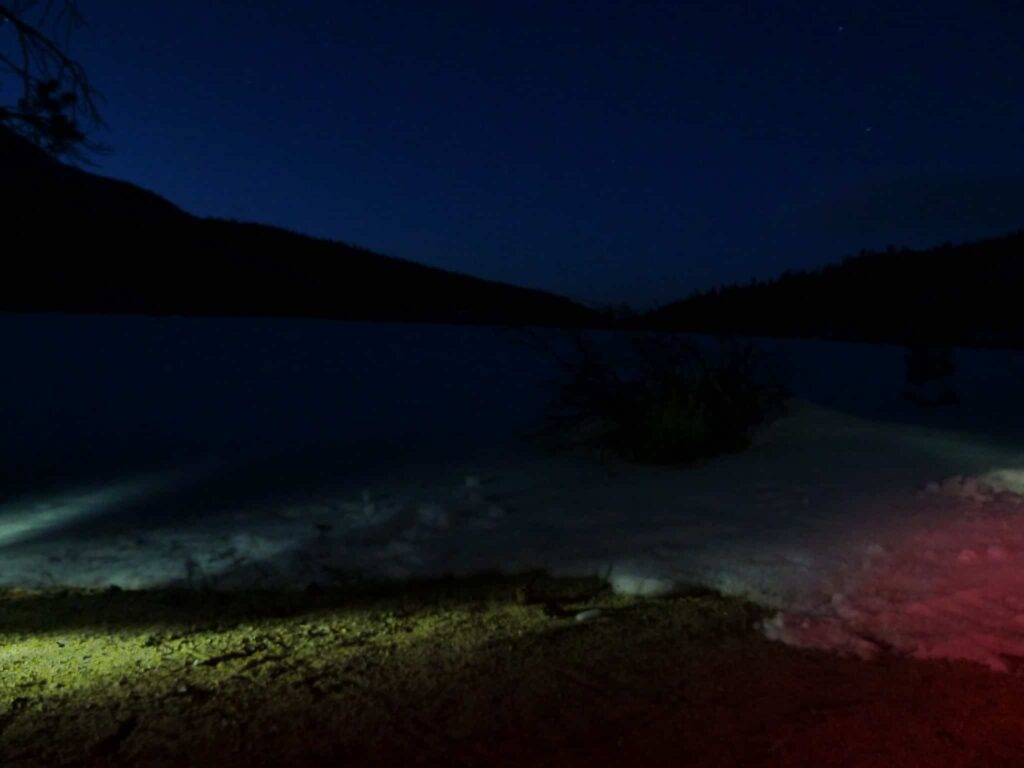
Unfortunately, peripheral vision is also more impacted by bright lights.
For example, your eyes involuntarily react when shot in the eye with a light beam. And, you lose your peripheral vision as they return to their ‘eagle eye’ stage. As a result, this temporarily blinds you and prolongs your inability to use your night vision.
Red lights are much softer on the eye and do not force that involuntary reaction that causes us temporary blindness.
2. Preserves Night Vision
Because your peripheral vision is your ‘owl eye,’ red light simultaneously helps preserve your night vision.
The retina hardly responds to red light at all, which allows your night vision to remain intact.
In fact, since red light is softer, it allows you to see more of your surroundings without being blinded.
Not only does it preserve your night vision, but it also saves the eyes of anyone around you.
For instance, when in a crowded campground or hiking with friends, the red light helps you see without blinding friends.
A normal flashlight beam is not only blinding to those around you, but also to those in nearby camps.
3. Eyes Focus Faster
Our eyes have evolved to work in both bright and dark environments. In fact, our eyes use cones to utilize our central vision during the day and rods to access your peripheral vision at night.
Furthermore, after about twenty minutes in the dark, or low light conditions, the eye produces something called rhodopsin. This is what actually activates our nighttime vision to its fullest potential.
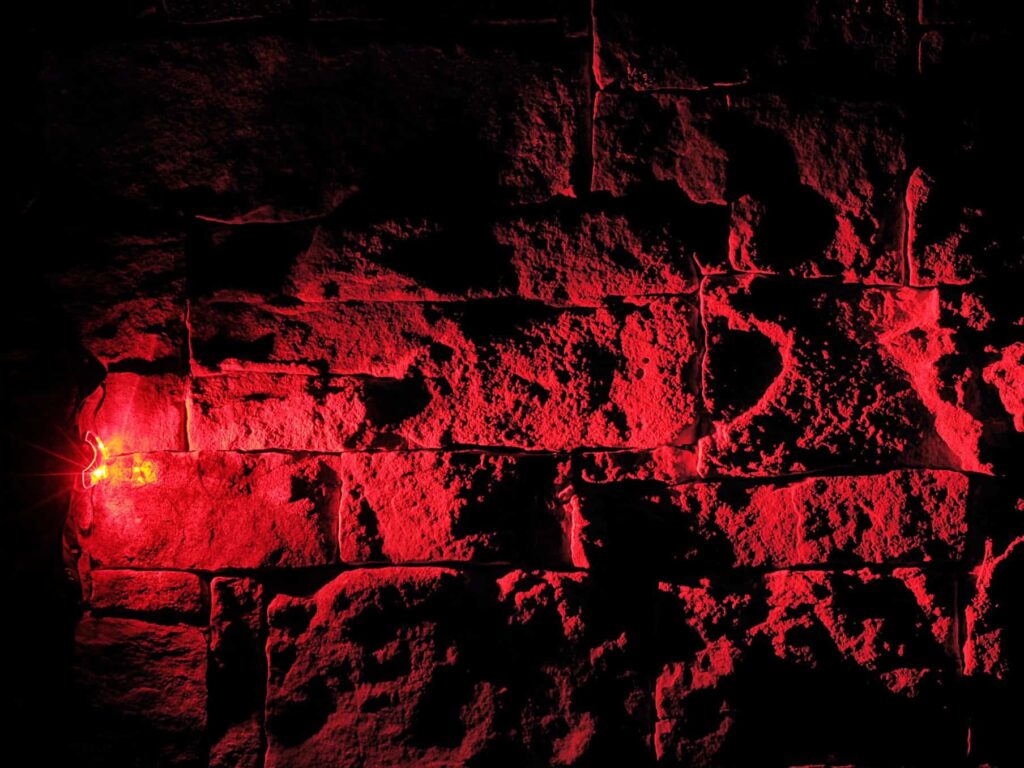
However, any exposure to bright light destroys this acquired protein, and the process must start all over again.
Fortunately, red light doesn’t disturb this light-sensitive receptor.
Instead, it allows the rods in the peripheral vision to perform their functions more effectively.
In fact, eyes focus much faster in the dark after building up the necessary rhodopsin.
4. Better for Stargazing
For the reasons mentioned above, red lights are essential for astronomers and those that enjoy stargazing.
If you’re an experienced stargazer, you’ll need a red light to view and adjust your planisphere or telescope.
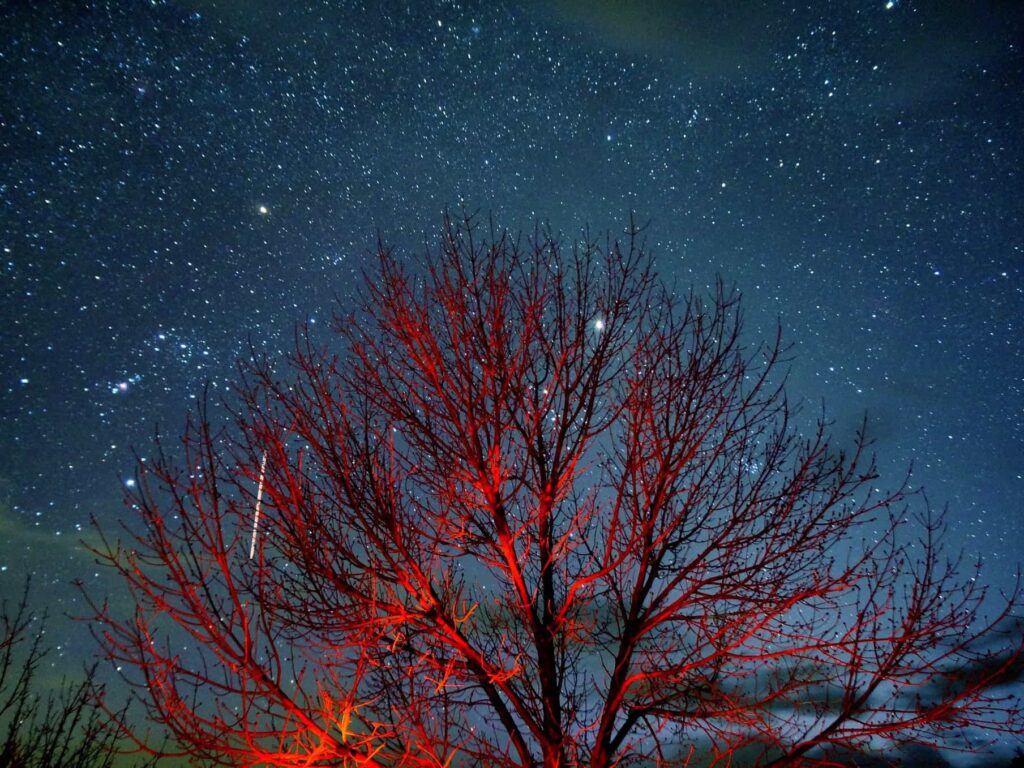
Even if you just enjoy viewing the stars with your naked eye, the red lights save your night vision.
Plus, nothing ruins a night under the stars like unnecessary light pollution.
Furthermore, if you’re heading out on a grand adventure with achingly low arches, check out our Best Hiking Boots for Flat Feet post.
5. Attracts Less Bugs
As we all know, bugs are attracted to light. But the kind of light really makes a difference. In fact, it’s why many homeowners s sport incandescent yellow porch lights.
In all actuality, though, red lights are one of the least visible lights to bugs.
Unfortunately, red lights have a stigma of signaling out dens of vice. However, when you’re camping red lights are totally acceptable, and work better for keeping bugs out of your face.
Red lights around your campsite during the nighttime hours keep the bugs away making your camping experience much more pleasant.
I used to be very confused by this red light. I’ve always wondered what is the red light for on a headlamp? Then on a hike I tried it out and was assaulted less by moths, mosquitos and flies.
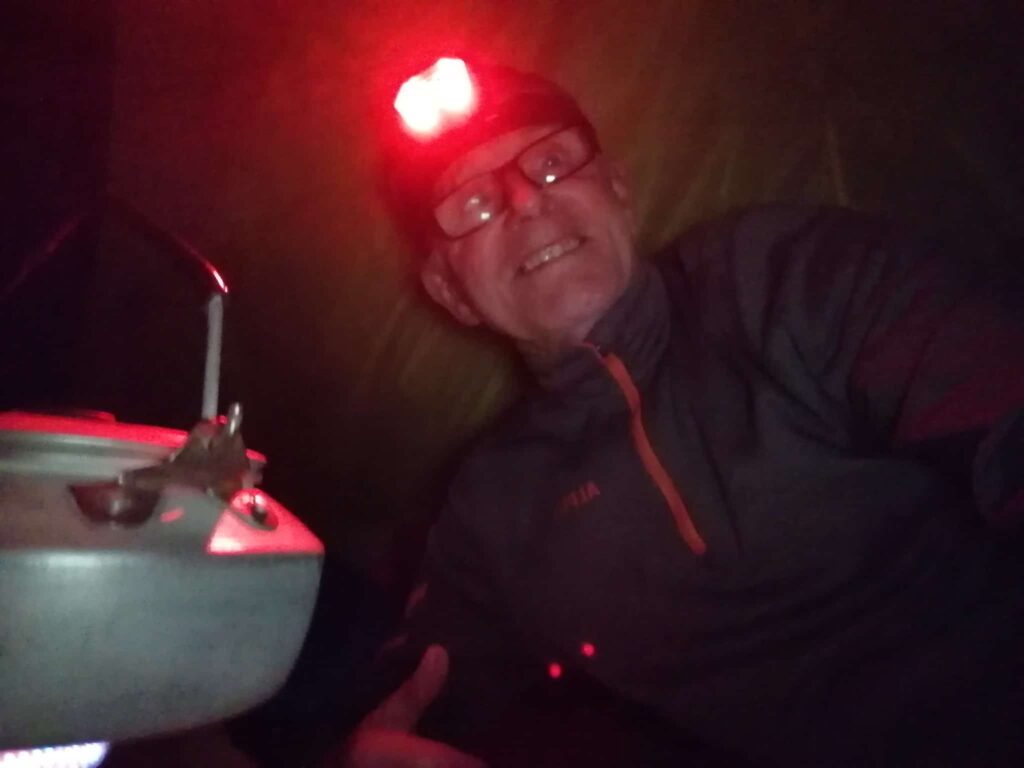
6. Easier to Read Maps and Books
Just like reading planispheres, red lights are much better for reading maps, books, or even playing cards.
Attempting to do any of these tasks in the dark is strenuous on the eyes.
Your eyes constantly go back and forth between ‘eagle eye’ and ‘owl eye.‘ Using a red headlamp or lantern prevents your eyes from constantly having to switch back and forth.
This is particularly beneficial when you’re hiking at night, stargazing, or performing movement-related activities in the dark. Navigating terrain in the dark is hard enough as it is without adding unnecessary eye strain.
The red lens reduces the strain on your eyes and makes transitioning back and forth much easier.
Many people what is the red light for on a headlamp before they see how much easier tasks become.

7. Doesn’t Disturb Nocturnal Wildlife
Fishermen and hunters particularly enjoy the benefits of the red light as they don’t scare the animals away.
The best time to find the wildlife is just before the sun comes up. Traversing with a red light allows you to see where you’re going in the dark. All without disturbing the very animals you’re trying to find.
It’s also great for taking the kids on a nighttime nature walk. There’s nothing more mesmerizing than watching wildlife in their natural environment.
The red lights make it easy to watch wildlife without scaring them away.
8. Saves Battery
Additionally, the brighter the lumens, the more energy required from your batteries. And, since red lights have very few lumens, they also require very little juice.
That means you can add plenty of extra hours to your battery life by using the red setting more often.
This is especially useful if you have a lamp or lantern with a drained battery.
And, if you’re worried about running out of juice, check out our 9 Headlamps with the Longest Battery Life post.
9. Better for Emergencies
Furthermore, most headlamps feature a strobing red light option predominantly used for emergencies.
The flashing red light attracts the attention of any passers-by that would otherwise not see you.
Nighttime explorers should always be prepared.

And an emergency strobe light should automatically be a part of your survival kit or emergency kit.
Our culture is indoctrinated to respond to the flashing red lights. Other lights, not so much.
For instance, we’re accustomed to seeing lights on emergency vehicles, cyclists, and traffic lights just to name a few. When we see flashing red lights, we usually pay attention. And, if you’re lost or hurt in the backcountry, you desperately want someone paying attention.
It's Time to Hike at Night
Learning how and when to use red lights appropriately can make your camping trip that much more fun and easy. If you haven’t experienced a nighttime nature walk or an evening of stargazing with the red light, try it!
We promise you won’t be disappointed, and you’ll probably enjoy the calm scenery like a nocturnal animal. It takes your camping experience to a whole new level.
About the Author
Sarah Sampsell
Title Image Credit, What is the Red Light for on a Headlamp: Eric Kilby | (source) | Attribution-ShareAlike 2.0 Generic (CC BY-SA 2.0) — reduced file size and image
Image Credit 1, What is the Red Light for on a Headlamp: Michael R Perry | (source) | Attribution 2.0 Generic (CC BY 2.0) — reduced file size and image
Image Credit 2, What is the Red Light for on a Headlamp: theilr | (source) | Attribution-ShareAlike 2.0 Generic (CC BY-SA 2.0) — reduced file size and image
What is the Red Light for on a Headlamp, Image Credit 3: Mike Lewinski | (source) | Attribution 2.0 Generic (CC BY 2.0) — reduced file size and image
What is the Red Light for on a Headlamp, Image Credit 4: summonedbyfells | (source) | Attribution 2.0 Generic (CC BY 2.0) — reduced file size and image
Image Credit 5, What is the Red Light for on a Headlamp: Washington Trails Association | (source) | Public Domain Mark 1.0 — reduced file size and image
Image Credit 6, What is the Red Light for on a Headlamp: Doug Letterman | (source) | Attribution 2.0 Generic (CC BY 2.0) — reduced file size and image

